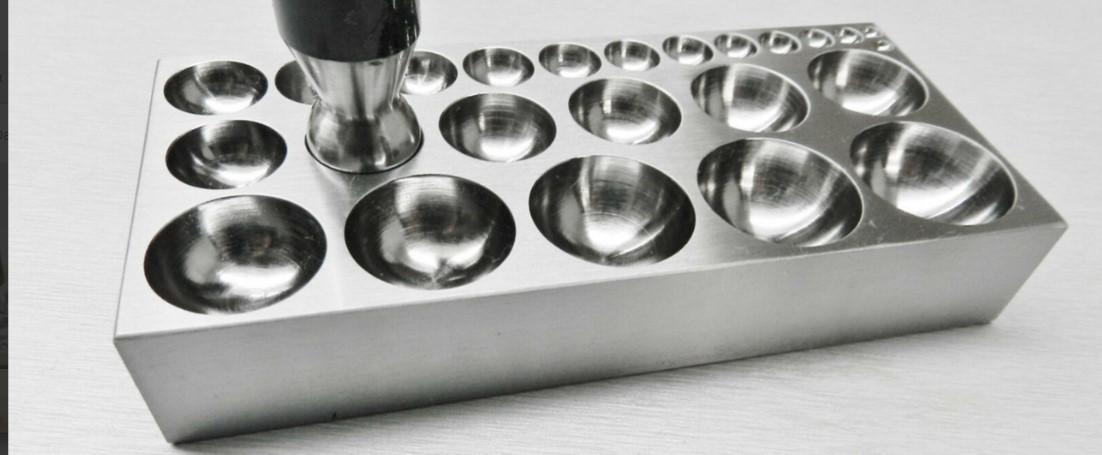Dapping is a fundamental technique in jewelry making that allows artisans to create beautifully rounded shapes and textures. This process involves shaping metal into domes or concave forms using dapping tools. Whether you're a beginner or an experienced jeweler, mastering dapping techniques can significantly enhance the uniqueness and appeal of your jewelry creations. This guide explores essential dapping techniques and their applications.
Essential Dapping Tools
Dapping Block
A dapping block is a solid block, typically made of steel or wood, with variously sized hemispherical depressions. These depressions are used to shape metal into domes or other rounded forms.
Dapping Punches
Dapping punches are rounded, cylindrical tools that correspond to the depressions in the dapping block. They are used to press the metal into the block's depressions to achieve the desired shape.
Rawhide or Rubber Mallet
A rawhide or rubber mallet is used to strike the dapping punches. These mallets are preferred over metal hammers because they minimize the risk of marring the metal surface.
Basic Dapping Technique
Step-by-Step Process
-
Prepare Your Metal: Cut your metal sheet into the desired size and shape. Anneal the metal if necessary to make it more malleable and easier to work with.
-
Select the Dapping Block Depression: Choose a depression in the dapping block that closely matches the size of the dome you want to create.
-
Position the Metal: Place the metal piece over the selected depression in the dapping block.
-
Choose the Appropriate Punch: Select a dapping punch that fits into the depression with enough clearance to press the metal without getting stuck.
-
Dap the Metal: Hold the punch firmly over the metal and depression, then strike the punch gently with a rawhide or rubber mallet. Gradually increase the force of your strikes as the metal starts to form into the depression. Rotate the punch slightly between strikes to ensure even shaping.
-
Finish the Shape: Continue dapping until the metal has taken the desired shape. If needed, use progressively smaller depressions and punches to achieve a more pronounced dome.
Advanced Dapping Techniques
Multi-Dimensional Dapping
To create multi-dimensional shapes, use different depressions and punches to form compound curves. For example, you can dap one half of a metal piece in one direction, then flip it and dap the other half in another direction to create a wave-like shape.
Texturing with Dapping
Incorporate texture into your domes by using texturing hammers or embossing the metal before dapping. This adds an extra layer of uniqueness to your creations.
Creating Concave Shapes
To create concave shapes, use the same basic dapping technique but place the metal piece inside out. This technique is useful for making bowl-like structures or settings for gemstones.
Layering Domes
Combine multiple domes of different sizes to create layered, three-dimensional designs. Solder or rivet smaller domes onto larger ones to build intricate and unique jewelry pieces.
Tips for Successful Dapping
- Anneal Your Metal: Regularly anneal your metal to keep it malleable and prevent cracking or breaking during the dapping process.
- Work Gradually: Start with light taps and gradually increase the force to avoid overstretching or damaging the metal.
- Keep Tools Clean: Ensure your dapping block and punches are clean and free of debris to avoid scratching the metal surface.
- Practice Patience: Dapping is a skill that improves with practice. Take your time to achieve smooth and even shapes.
Applications of Dapping in Jewelry Making
Domed Pendants and Earrings
Dapped domes make beautiful pendants and earrings. Their rounded shape catches the light and adds a sophisticated touch to any design.
Gemstone Settings
Create unique settings for cabochons or other gemstones by dapping metal into concave shapes. This provides a custom fit for the stones and enhances their presentation.
Textured Bracelets
Incorporate dapped elements into bracelets for added texture and dimension. Layering domes or creating wave-like forms can transform a simple bracelet into a statement piece.
Decorative Elements
Use dapped shapes as decorative elements in various jewelry pieces, from rings to brooches. The rounded forms add visual interest and complexity to your designs.
Conclusion
Mastering dapping techniques opens up a world of possibilities for creating unique and captivating jewelry. By understanding the basics and experimenting with advanced methods, you can incorporate beautiful domed and concave shapes into your designs. With practice and creativity, dapping can become an integral part of your jewelry-making repertoire, allowing you to craft pieces that stand out for their elegance and originality.
